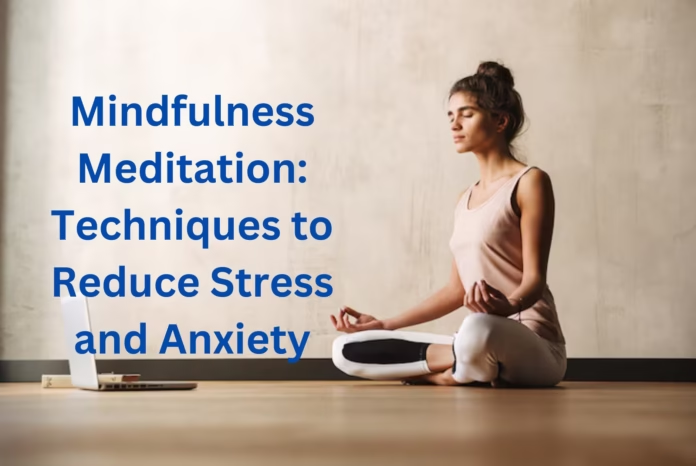In today’s fast-paced world, stress and anxiety often feel like unwanted companions. Between work demands, family responsibilities, and the never-ending pressure to stay connected online, it’s easy to feel like you’re drowning. Maybe you’re here because you’ve felt that kind of exhaustion—the kind that doesn’t go away even after a good night’s sleep. If that sounds familiar, know that you’re not alone, and more importantly, that there’s a way to find some peace. That’s where mindfulness meditation comes in.
Mindfulness meditation isn’t about trying to shut out the world or forcefully silence your thoughts. Instead, it’s about learning to be here, right now—no matter how messy or noisy that moment might be. It’s about training your mind to be present, to acknowledge what is happening without judgment or resistance. And here’s the beauty of it: you don’t need fancy equipment, a particular setup, or hours to dedicate. All you need is you—showing up, even if it’s for a few minutes.
Whether you’re just starting out or looking to deepen your mindfulness practice, this guide is designed to help you on your journey to a calmer, more centered version of yourself. Let’s explore together how mindfulness can help you navigate life with a little more grace.
What is Mindfulness Meditation?
Mindfulness meditation is a practice that invites you to come back to the present moment. Imagine standing at the edge of a river. Your thoughts are like leaves floating downstream—constant, never-ending. Rather than jumping in to grab each leaf or fight the current, you simply observe. You let the leaves float by. You notice their shapes, their colors, and their movement. This gentle, non-judgmental observation is at the heart of mindfulness. You don’t have to change anything or control what’s happening; you just need to notice it.
One of the most freeing aspects of mindfulness is that it can be practiced anywhere. You don’t need a meditation pillow or a quiet mountaintop (though those are nice if you have them). You can practice while you’re in traffic, waiting at the grocery store, or even brushing your teeth. This simple shift—learning to observe instead of react—can fundamentally change how you experience stress and anxiety.
Why Mindfulness Works: The Benefits
Mindfulness isn’t a magic bullet, but it is a powerful tool. Here are some of the ways that mindfulness can make a real difference in your life:
- Reduced Stress
Stress is inevitable, but your reaction to it doesn’t have to be. Mindfulness helps you break the habit of letting stress take over. By anchoring yourself in the present, you can take a mental step back from the frantic worrying that usually accompanies stress. Studies have shown that mindfulness lowers cortisol—the body’s primary stress hormone—allowing you to feel more in control. - Lower Anxiety
Anxiety often comes from our tendency to live in the “what ifs” of the future. Mindfulness teaches you to sit with those thoughts rather than be swept away by them. Over time, anxiety starts to lose its hold because you’ve stopped giving those thoughts power over you. - Better Emotional Regulation
Have you ever snapped at someone and regretted it the instant the words left your mouth? Mindfulness gives you the pause that makes all the difference. It allows you to take a breath before you respond, which can completely change the outcome of challenging situations. - Improved Focus and Concentration
In a world where distractions are always just a click away, mindfulness can help you reclaim your focus. Whether it’s giving undivided attention to a loved one or completing a work task, mindfulness trains your mind to stay in the moment. - Enhanced Sleep Quality
If you’ve ever struggled to fall asleep because your mind keeps replaying the day’s events, mindfulness can help. Practicing mindfulness meditation before bed can help you let go of those racing thoughts, giving your mind permission to rest.
How Does Mindfulness Meditation Work?
Think of your thoughts as waves on the ocean. When you’re not practicing mindfulness, it’s easy to feel tossed around by those waves—up and down, over and over. But mindfulness teaches you to step back and watch the waves from the shore. You realize that you are not the waves; you’re the observer. And that realization brings immense power. You start to understand that the waves can crash and swirl, but they don’t control you.
Mindfulness also changes your brain. Scientific studies have shown that regular mindfulness practice can actually increase the density of gray matter in areas linked to emotional regulation and self-awareness. Essentially, the more you practice, the more your brain adapts to help you handle stress, stay focused, and maintain emotional balance.
Mindfulness Techniques to Help You Reduce Stress and Anxiety
Mindfulness doesn’t have to be complicated. Here are some simple techniques that you can try today to help bring a little more calm into your life:
1. Breathing Meditation
How to Do It: Find a comfortable, quiet spot. Close your eyes and take a deep breath in, then exhale slowly. Let your breathing return to its natural rhythm. Focus on the sensation of your breath entering and leaving your body.
2. Body Scan Meditation
Lie down or sit comfortably. Close your eyes and bring your focus to your feet. Notice any sensations you feel—tingling, warmth, or discomfort. Slowly move your focus up your body, noticing what you feel at each point.
3. Walking Meditation
During walking meditation, focus on each step. Feel your feet making contact with the ground. Notice the rhythm of your movement, the sounds, and the air on your skin.
4. Loving-Kindness Meditation
Sit quietly and close your eyes. Start with yourself—silently repeat phrases like, “May I be happy. May I be healthy.” Then, expand this kindness outward: to someone you love, an acquaintance, and someone you struggle with.
5. The 5-4-3-2-1 Grounding Technique
When anxiety creeps in, identify five things you see, four things you touch, three things you hear, two things you smell, and one thing you taste.
Bringing Mindfulness into Your Everyday Life
You don’t need a special time set aside to practice mindfulness. It can be woven into the fabric of your day:
- Mindful Eating: Take time to really taste your food. Notice the textures, flavors, and aroma.
- Mindful Listening: When someone talks to you, really listen. Put away your phone and be present.
- Mindful Mornings: Start your day mindfully by focusing on a part of your routine.
Building a Consistent Practice
Creating a habit of mindfulness is about starting small and being patient with yourself. Just like building any habit, consistency is more important than intensity. Here’s how you can build a consistent practice:
- Start Small and Stay Consistent
Begin with 2-5 minutes of mindfulness each day. - Set a Specific Time
Link mindfulness to a routine activity, like drinking coffee or commuting. - Use Reminders and Triggers
Set alarms, use mindfulness apps, or place sticky notes for gentle reminders. - Be Patient and Non-Judgmental
Each time your mind wanders, gently bring it back to the present. - Make It Enjoyable
Explore forms of mindfulness that you enjoy, like walking meditation or mindful cooking. - Track Your Progress
Keep a mindfulness journal to reflect on your practice. - Join a Community
Connect with others by joining an online meditation group or attending a class.
Conclusion: Embrace the Journey of Mindfulness
Mindfulness meditation isn’t about achieving a perfect state of calm. It’s about showing up for yourself, moment by moment, and choosing presence over distraction. The benefits—reduced stress, lower anxiety, better sleep, and improved relationships—are cumulative.
Start small, be consistent, and remember that mindfulness is a journey, not a destination. Each moment you spend practicing is a moment spent nurturing your well-being. Why not start today? Take just one minute to pause, breathe, and experience the present moment just as it is.




